Why are people excited about embedded insurance

As many of our wonderful customers know, WeCovr is an insurtech with a particular focus on Embedded Insurance, meaning we can build our insurance solutions into clients' offerings to enhance their users' experience and customer value. We do this by using our APIs and insurance expertise and capabilities. We've already launched and are working on launching even more embedded insurance projects.
Below is a quick summary we've put together of an excellent thought piece(albion.vc) on Embedded Insurance by Jessica Bartos of AlbionVC.
Why we are excited about embedded insurance in 2021
At Christmas 2020, online sales as a percent of total retail reached 32% in the UK, advancing almost the last decade’s worth of ecommerce penetration in just one year. More surprisingly, the crisis has shown us that consumers are willing and able to make even very high value or complex purchases online. For instance, Cazoo’s banner year proved that the notoriously offline car purchase can be done successfully online at scale.
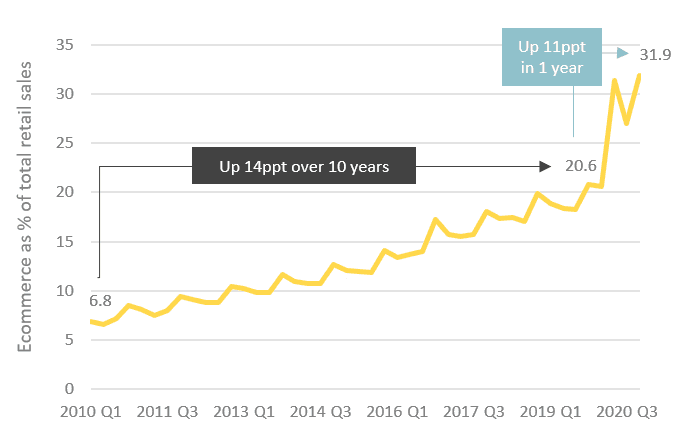
A knock-on effect of society’s accelerated consumption of digital services will be a similar acceleration towards embedding insurance into digital offerings. Embedded insurance is the bundling of coverage or protections within the purchase of a product or service. The insurance product is not sold to the customer ad hoc but is instead provided as a native feature. In this post, I’ll explain why tech is so well positioned to offer insurance in this way and why embedded insurance creates a win-win-win outcome for tech, insurance and consumers alike.
To set out the problem: a system in which the insurance purchase is separate from the purchase of the product or service associated with the underlying risk is ineffective and inefficient. Insurance is an afterthought or rejected as an unappealing hassle, resulting in protection gaps, estimated to be c. $1.2 trillion globally. The size of this gap is growing, having doubled over the last 20 years due to urbanisation, digitisation, climate change and lack of innovation.
When consumers do buy insurance, the customer journey is poor and mostly offline. For instance, while 74% of consumers research their insurance online (expressing their intent to buy digitally), only 25% are able to complete their purchase online.
But embedding insurance in digital services can fix what’s wrong with insurance today. Embedded insurance offers insurance when the risk is top of mind for the buyer. And it brings insurers closer to the underlying risks. Tech players — whether ecommerce, SaaS or digital services — are well suited to embed insurance into their platforms because, in our online world, they control four critical pieces of the insurance puzzle: 1) customer journey, 2) data, 3) trust, and 4) communication
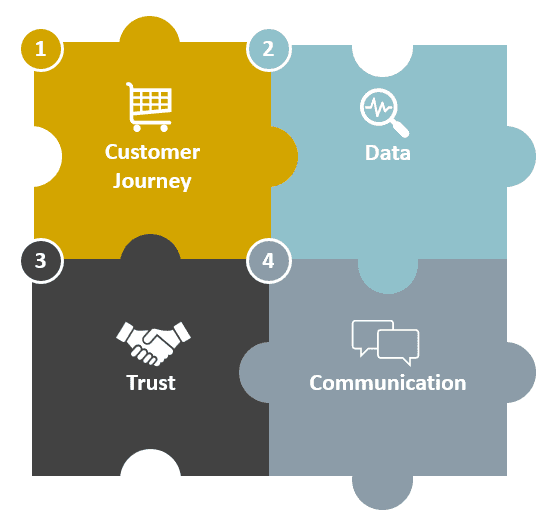
The biggest tech ecosystems, such as Amazon, Apple, Google and Alibaba, that bring together services, marketplaces and devices into one trusted experience, will be especially powerful in embedded insurance. But those who can play in embedded insurance is broader than just the largest tech giants. It could also encompass an array of digital-first disruptors in various verticals:
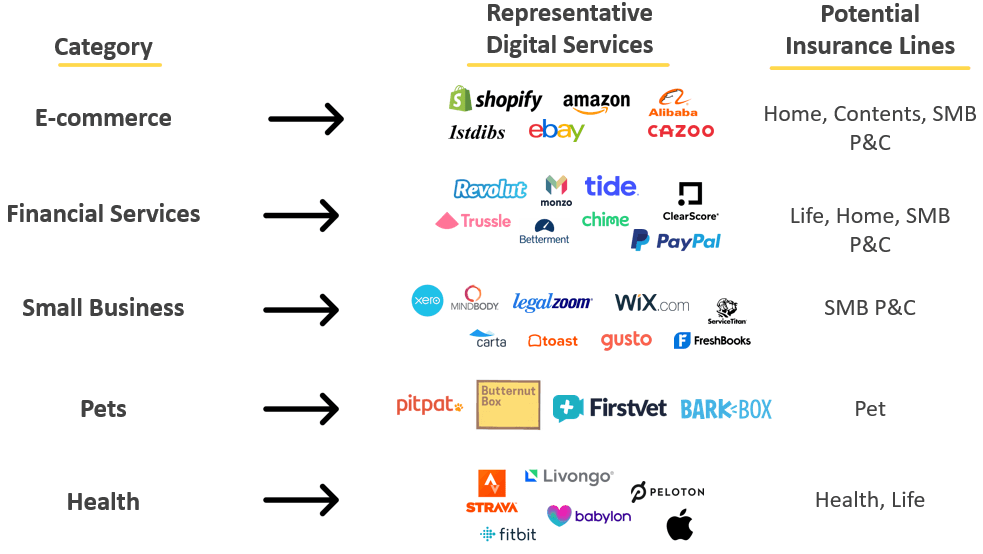
I’d argue that if your digital business has control of the customer, the data, the trust and the communications, you’re well-placed to embed insurance.
- Customer Journey
First, as more of life happens online, tech players control the customer journey. They can serve an insurance offering to a buyer exactly when it is most relevant to them, increasing conversion rates compared to a separate purchase of insurance. Meeting the customers where they are should expand the amount of insurance that is purchased in the first place, closing protection gaps. Digital players can easily weave the insurance purchase into the customer workflow to reduce friction, as compared to incumbent insurers’ failed attempts to build functioning, pleasant online purchase journeys.
For tech players, embedded insurance adds a high margin revenue stream. For example, one of the best penetrated embedded insurance categories is insurance into the rental car customer journey – selling extra insurance at the checkout counter. In car rentals, there is intense price competition leading to razor thin margins on the standalone car bookings. But the add-on insurance is extremely high margin. In these businesses, the insurance and other ancillary services often drive over 100% of the profits.
- Data
Tech players’ second asset is their control of data. As offline services come online, vast amounts of data are collected. Digital services end up having the most data about risk. Depending on the type of service, the nature of the data collected and its relevance to insurance varies. 
By contrast, the status quo insurance purchase asks the customer to provide data about the risk in a separate process. In the first place, the data entry process creates friction in buying insurance. Further, this data often has limited fidelity to the truth as people forget information (what material is my roof made of? how much is that jewellery worth?), misunderstand what the insurer is asking (just what is a BS 3621 lock?) or do not report things correctly (have you really never smoked?). And importantly, the data is not updated in real time; it is based on static, historic demographics than actual risk behaviour in real time.
- Trust
Third, digital services command high levels of consumer trust. Tech companies have created superior customer experiences and developed powerful brands, manifested in their sky-high NPS scores. Digital services have an average NPS of 75 vs an average of 30 across various lines of insurance.
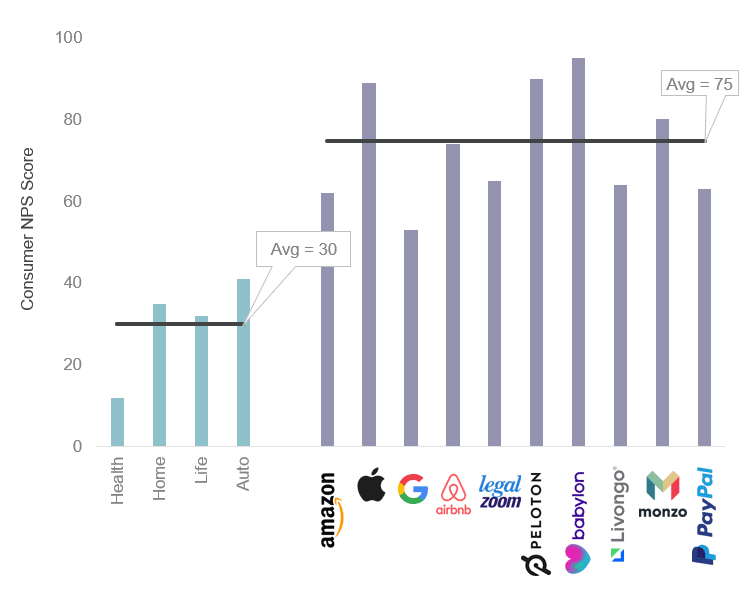
By contrast, insurance brands are weak and command little customer loyalty. For instance, in the UK, 73% of consumers are looking to switch their insurance provider.
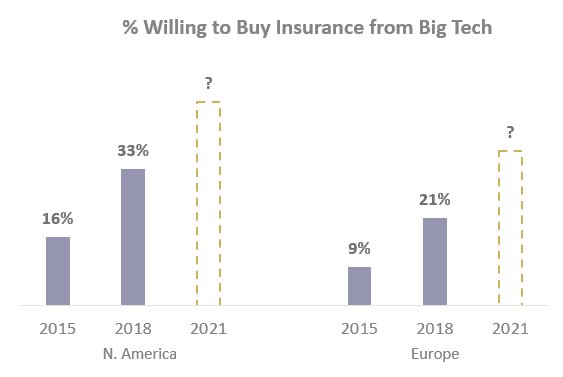
Embedded insurance presents an opportunity to arbitrage this trust gap between insurance and digital. Insurers can piggyback on the positive customer experiences and brands of digital platforms to get better distribution and differentiate. In turn, the tech players get to leverage their hard-earned brands into additional high margin revenue streams and a longer, deeper relationship with their users. As early as 2018, we started to see green shoots of consumer willingness to buy insurance from Big Tech, but we expect this trend to accelerate dramatically.
- Communication
Finally, tech players are fluent in “millennial” and command high frequency, positive communication channels with their users.
Millennials and younger generations now make up over 50% of the US population. However, this generation is the least engaged with insurance. According to Gallup, Millennials are twice as likely as other generations buy insurance online and yet are the least satisfied with existing digital insurance options. This explains how new entrants like Lemonade reach multi-billion dollar market caps ($9bn at the moment, up almost 200% from its IPO price), not just on the basis of their written premium growth but due to the promise of unlocking the Millennial insurance consumer. Meanwhile, digital services speak to Millennial and Gen Z cohorts natively, building brands and experiences that naturally delight them.
What will 2021 bring for embedded insurance
With digital consumption unexpectedly accelerating, new and greater risk protection gaps are arising. Embedded insurance creates a win-win proposition for both tech players and insurers to better protect consumers and strengthen value propositions. Tech players’ control of the customer journey, their data, their trust, and the lines of communication make them best placed to bring insurance into the 21st century.
Insurers represent 10% of the Fortune 500 and industry net profits were over $100 billion in 2019 in the US alone. Yet there has been minimal innovation and a glacial pace of transition to a world of digital consumption. If insurers don’t innovate, someone will come after those profit pools. As Jeff Bezos famously said, “Your margin is my opportunity.” And insurance presents a world of opportunity — for those ready to embed it in our digital lives.
2021 will be the year when embedded insurance starts to come into its own. With Stripe, every company can now offer online payments. With Klarna, every company can offer buy-now-pay-later. We’re excited to find the start-up that enables every company to offer insurance.
Why private medical insurance and how does it work?
What is Private Medical Insurance?
Private medical insurance (PMI) is a type of health insurance that provides access to private healthcare services in the UK. It covers the cost of private medical treatment, allowing you to bypass NHS waiting lists and receive faster, more convenient care.How does it work?
Private medical insurance works by paying for your private healthcare costs. When you need treatment, you can choose to go private and your insurance will cover the costs, subject to your policy terms and conditions. This can include:• Private consultations with specialists
• Private hospital treatment and surgery
• Diagnostic tests and scans
• Physiotherapy and rehabilitation
• Mental health treatment
Your premium depends on factors like your age, health, occupation, and the level of cover you choose. Most policies offer different levels of cover, from basic to comprehensive, allowing you to tailor the policy to your needs and budget.
Questions to ask yourself regarding private medical insurance
Just ask yourself:👉 Are you concerned about NHS waiting times for treatment?
👉 Would you prefer to choose your own consultant and hospital?
👉 Do you want faster access to diagnostic tests and scans?
👉 Would you like private hospital accommodation and better food?
👉 Do you want to avoid the stress of NHS waiting lists?
Many people don't realise that private medical insurance is more affordable than they think, especially when you consider the value of faster treatment and better facilities. A great insurance policy can provide peace of mind and ensure you receive the care you need when you need it.
Benefits offered by private medical insurance
Private medical insurance provides numerous benefits that can significantly improve your healthcare experience and outcomes:Faster Access to Treatment
One of the biggest advantages is avoiding NHS waiting lists. While the NHS provides excellent care, waiting times can be lengthy. With private medical insurance, you can often receive treatment within days or weeks rather than months.
Choice of Consultant and Hospital
You can choose your preferred consultant and hospital, giving you more control over your healthcare journey. This is particularly important for complex treatments where you want a specific specialist.
Better Facilities and Accommodation
Private hospitals typically offer superior facilities, including private rooms, better food, and more comfortable surroundings. This can make your recovery more pleasant and potentially faster.
Advanced Treatments
Private medical insurance often covers treatments and medications not available on the NHS, giving you access to the latest medical advances and technologies.
Mental Health Support
Many policies include comprehensive mental health coverage, providing faster access to therapy and psychiatric care when needed.
Tax Benefits for Business Owners
If you're self-employed or a business owner, private medical insurance premiums can be tax-deductible, making it a cost-effective way to protect your health and your business.
Peace of Mind
Knowing you have access to private healthcare when you need it provides invaluable peace of mind, especially for those with ongoing health conditions or concerns about NHS capacity.
Private medical insurance is particularly valuable for those who want to take control of their healthcare journey and ensure they receive the best possible treatment when they need it most.
Important Fact!
We can look at a more suitable option mid-term!
Why is it important to get private medical insurance early?
👉 Many people are very thankful that they had their private medical insurance cover in place before running into some serious health issues. Private medical insurance is as important as life insurance for protecting your family's finances.👉 We insure our cars, houses, and even our phones! Yet our health is the most precious thing we have.
Easily one of the most important insurance purchases an individual or family can make in their lifetime, the decision to buy private medical insurance can be made much simpler with the help of FCA-authorised advisers. They are the specialists who do the searching and analysis helping people choose between various types of private medical insurance policies available in the market, including different levels of cover and policy types most suitable to the client's individual circumstances.
It certainly won't do any harm if you speak with one of our experienced insurance experts who are passionate about advising people on financial matters related to private medical insurance and are keen to provide you with a free consultation.
You can discuss with them in detail what affordable private medical insurance plan for the necessary peace of mind they would recommend! WeCovr works with some of the best advisers in the market.
By tapping the button below, you can book a free call with them in less than 30 seconds right now:
Our Group Is Proud To Have Issued 800,000+ Policies!
We've established collaboration agreements with leading insurance groups to create tailored coverage

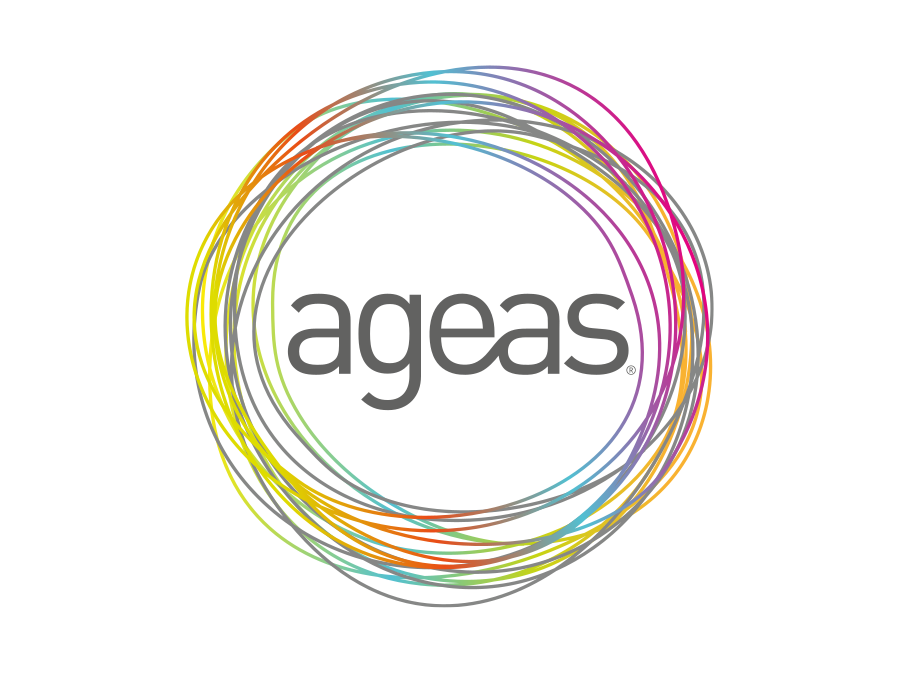






















How It Works
1. Complete a brief form

2. Our experts analyse your information and find you best quotes

3. Enjoy your protection!

Any questions?
Learn more

Who Are WeCovr?
WeCovr is an insurance specialist for people valuing their peace of mind and a great service.👍 WeCovr will help you get your private medical insurance, life insurance, critical illness insurance and others in no time thanks to our wonderful super-friendly experts ready to assist you every step of the way.
Just a quick and simple form and an easy conversation with one of our experts and your valuable insurance policy is in place for that needed peace of mind!